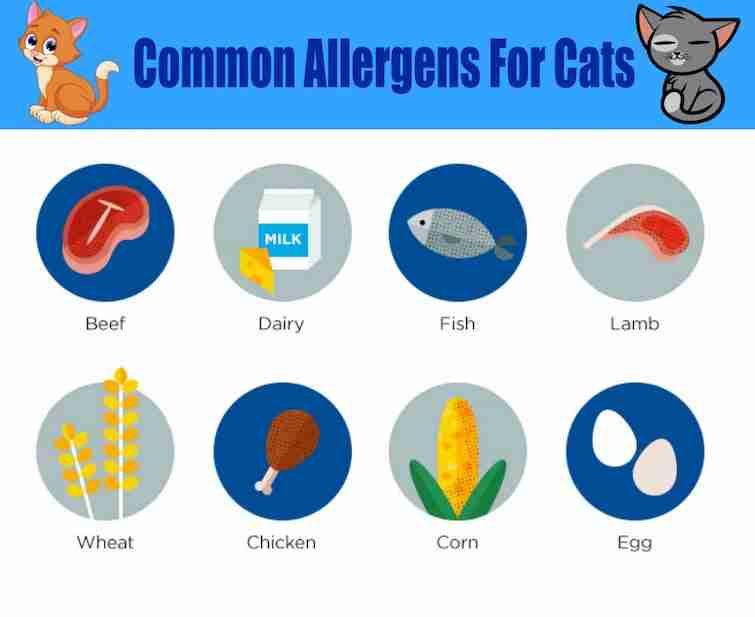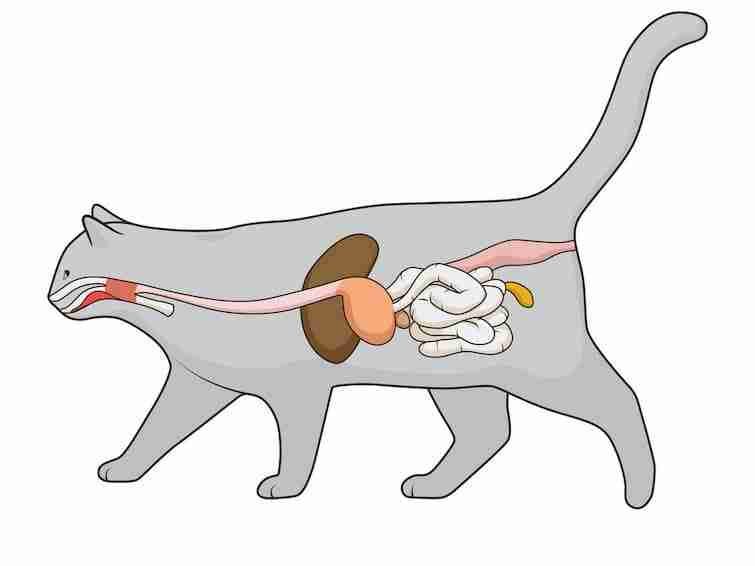When you decide to get a pet, you agree on taking huge responsibility for a living being. You become its master, friend, sitter, vet, and playmate when necessary. Sometimes you may also become their vet and “mom” who carefully watches its diet and tries to eliminate dangerous situations. In this article you will learn how to spot food allergy in your cat.
Your fluffy friend’s immune system may be sensitive to certain substances and treat them as “dangerous” while they can be completely harmless for someone else. Actually, the same happens with people, so there is nothing surprising in it. Just you should be aware of the problem and know how to handle this or that situation without panic.
What is a food allergy?
Since there are many different types of this disease, it is worth highlighting the peculiarities of the food one. About 15% of kittens are allergic to some products. And if you don’t pay much attention to your cat’s eating schedule and the possible root causes of its allergy, it can be complicated for a vet to diagnose and treat it since there are no reliable diagnostic tests. Thus, it is up to you to recognize this disease’s common symptoms and take some fast actions if the problem is threatening health.
In fact, a food allergy takes place when your furry friend’s immune system perceives a food protein (in most cases) as an invader, evoking an immune response. The latter can have various manifestations, starting with itchy skin and vomiting, diarrhea, etc. The key moment here is that numerous factors may also cause gastrointestinal issues.
For instance, parasites, many types of viruses, and infections may have similar manifestations, not to mention cases when your pet has just eaten something it shouldn’t. Besides, your pet may not have an allergy but intolerance to a certain product when it comes to food. As you see, to diagnose a food allergy may be a real challenge.
How to diagnose a food allergy?
It’s really frustrating that there is no easy and fast test to spot a food allergy. Even though the modern market and veterinarians offer various methods to diagnose a food allergy, using saliva or blood, there is no scientific proof that these options work out.
It doesn’t matter what exactly test you choose (among the currently available), and the results you get will not be 100% accurate. And the researchers have proved that even though all these tests are used here and there (both by vets and pets’ owners), they don’t help much in fact, and there is always room for the mistake.
The most effective way to spot allergy in your kitty is to decrease the list of products you feed your cat with. As easy as it is. It means that your beloved pet should strictly keep a diet created by your vet (or you). Usually, it consists only of several ingredients (one from each group) that your cat has never tried before. Note that this diet must be the only thing your cat is eating for two months or more, depending on its symptoms and how soon they disappear.
You shouldn’t make any exceptions “for a day” or something. If your pet’s condition improves drastically during this period, to confirm the allergy, you add one old product per time and continue to feed it like that for several weeks. Thus, you will be able to define the specific product that triggers the issue and cause so many problems. Before this trial period, you should also get rid of fleas if they present.
What products are the most common sources of allergy?
 Many people confuse allergies with food intolerance, but the latter one is not life-threatening. How to distinguish one from another? While a food intolerance may cause digestive issues, including diarrhea and bloat, a food allergy evokes inching and makes the cat scratch a lot.
Many people confuse allergies with food intolerance, but the latter one is not life-threatening. How to distinguish one from another? While a food intolerance may cause digestive issues, including diarrhea and bloat, a food allergy evokes inching and makes the cat scratch a lot.
Your kitty may start licking itself or scratching all the time that will lead to fur loss and red bumps all over the body. The main thing here is that it may lead to many serious problems like difficulty breathing, anaphylaxis, and even loss of consciousness.
Nonetheless, one should remember that any cat may develop both food allergy and product intolerance. Even though your pet may turn out to be allergic to any product, some types are pretty common sources of this issue. Let’s figure out what products you should eliminate in the first place, making up a dietary program for your furry friend, if something.
Artificial coloring
If you believe that there is no difference between expensive and cheap cat food since you pay for “brand,” it’s worth paying attention to the food composition. Some cheap cat food brands use artificial coloring to attract pet owners with its “more natural colors” of food. And this artificial component can be the root cause of this disease in your fluffy friend.
Corn products
You might know at least one person who is allergic to corn, and you cannot even imagine how many cats suffer from this problem. However, cornmeal is often one of the main ingredients of cheap cat food. This type of allergy often results in itchy skin.
Dairy products
If you search for products that you should never ever feed your cat with, you will be surprised to find dairy products on such a list. However, the truth is that most adult cats are lactose intolerant, and their gut cannot digest such products, especially in big amounts. So, if you notice that your cat vomits or has diarrhea after a portion of milk, you know why it has happened.
Meat byproducts
Again, when it comes to cheap pet food, you run into another potential allergen. Thus, meat byproducts are commonly used in such types of cat food. They represent the excess organs, fats, and tissues that people don’t eat from animals.
The main problem is that there is no strict quality control, so it may contain proteins that cause an allergic response in your furry friend.
Preservatives
You might have wondered why they indicate “no preservatives” on labels. The fact is that food preservatives (indicated as BHA and BHT) often cause an allergy both in humans and animals, so it’s not surprising it’s important to consume products free of them.
Seafood
Many cats are crazy about seafood and fish, but you should better avoid feeding your furry friend with such things. The research has proved that seafood is one of the most common sources of allergy.
How to treat a food allergy?
The most effective way to prevent appearing symptoms is a specialized diet that suggests the absence of allergy sources. Otherwise, all other options will have an only temporary effect and may lead to unpleasant consequences over time.
You can turn to a vet nutritionist that will help you create a well-tailored diet that will completely meet your pet’s needs. Besides, they may give you some tips on how to change their diet over time to prevent the occurrence of such situations.
To ensure a fast relief of symptoms, a vet may prescribe antihistamines. And if there is a secondary bacterial infection (because your cat has scratched itself too much) in the skin, you will not do without antibiotics and special creams to expedite the healing process.
In most cases, the prescription will stay valid for about three weeks or more. However, all these medicines will not help in the long run if you do nothing with your cat’s diet. The very thing it can do is to ease the suffering of your pet right away. And when you move to the diet, your furry friend may need probiotics to normalize food digestion.
Recovery of food allergies in cats

Suppose you have done everything provided above, but food allergy symptoms don’t vanish in about nine weeks or so after the beginning of the diet. In that case, you should visit your vet to check the diagnosis and correct treatment if necessary.
If your cat’s gastrointestinal tract hasn’t been detoxified and healed properly, your furry friend may continue suffering from food allergy symptoms. Also, If you have already found several protein sources (types of meat) that don’t evoke allergy symptoms, you can stop feeding your cat with new foods. If new food causes allergy symptoms again, you will have to change the diet and start treatment all over again.
Suppose you want to eliminate situations connected with a food allergy in your cat. In that case, it is worth studying the peculiarities of its breed and picking up species-appropriate nutrition for your furry friend. It is worth spending some time studying dry cat food composition to make sure it is free from potentially dangerous components.
Summary
Don’t try to save a penny on your cat’s food, choosing low-quality protein sources since the chances are high you will pay a double price for its treatment in the future. And as it has already been mentioned, grain fillers should also be excluded from your cat’s diet since it brings more harm than good or more precisely, it doesn’t bring anything good at all.
Kitties with allergies are not unicorns, so every person who is going to get a kitty should know how to choose the best wet and dry kitten food, spot a food allergy, and deal with it ASAP. If you decide to get a special breed, it is worth contacting a cat nutrition specialist to make the best diet possible for your cat and avoid food allergies in the future.
Last Updated on 16/03/2025 by Karen Snow
Hi! I’m Karen and a certified dog lover. As a freelance writer and blogger, I do my best to squeeze in some time with my dogs, learning more about the way they act and how I can make sure that they continue to stay well-cared for by yours truly.
My dogs have helped me through a lot, and this is my way of giving back to them! Besides animals, I also love to travel and cook, having explored my country’s restaurants and unique places. Follow me as I show you all the amazing tips and bits of information I learn along the way about our furry friends!
